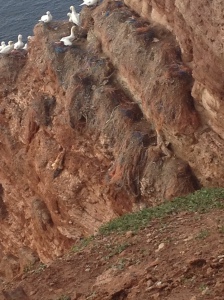Wednesday at week-long conferences is usually the day with excursions. Today, we started out with some talks in the morning, among them Alexey Sukhotin showing different studies done at the Russian field station Kartesh in the White Sea over the last 50 years. This was very interesting to us, as Lena went there in 1995 and we would like to return and do some experiments on their Fucus vesiculosus populations.
Also, Hartvig Christie held another talk on the Norwegian kelp forests and seagrass beds, this time on how they can survive being both food and habitat. This study clearly shows how fish help maintaining the kelp and seagrass by feeding on the any grazing gastropods and crustaceans that would otherwise prove too much grazing pressure for these ecosystems.
Since the sun was out and the wind was low, we went for a discovery trip up on the oberland, admiring the view of the North Sea horizon and the interesting geology of the island.
We took our packed luch by the nesting colony of Northern gannet, Morus bassanus.
It was rather sad to see how they have used plastic or nylon netting for nesting material. Several young birds have gotten entangled in the nets and died, so the colonies were draped with more or less mummified birds hanging from the rock.
After some mandatory selfies at Long Anna at the tip of the island, we walked back towards unterland, passing the local allotment area. Gardening here is very affected by the wind, but lots of dense hedges seems to do the trick.

The allotment gardeners have plenty of sun, rain and seaweed as fertilizer. Using hedges to screen out the wind makes for bumper crops.
In the afternoon, we took the boat over to Düne to look at the seals and browse the shores there for interesting finds. There are so many beautiful speciments of Laminaria hyperborea kelp here, and I would like to bring all of them home. Best not, I think. A kelp forest in a small appartment might not be such a good idea.
After enjoying the dune-landscape with its typical flora and falcons, we strolled to the southern beach, where the conference dinner and Yellow Submarine competition would be held. The Yellow Submarine has been running since 1968 and although its all in good fun, it is still a prestigeous prize to win.
This year, we entered a strong team for Sweden, with no less than 3 professors and one fresh-from-the-oven doctor. Lena and Nils kautsky, Angela Wulff and yours truly worked hard, spinning around bottles, answering questions while building sand castles and collecting water (huge effort by aquatic gazelle Angela).
All the teams did very well and the winner will be announced later in the week. The evening ended pleasantly late after drinks and high spirits amongs all.









